Diatomaceous earth and how to use it for chickens
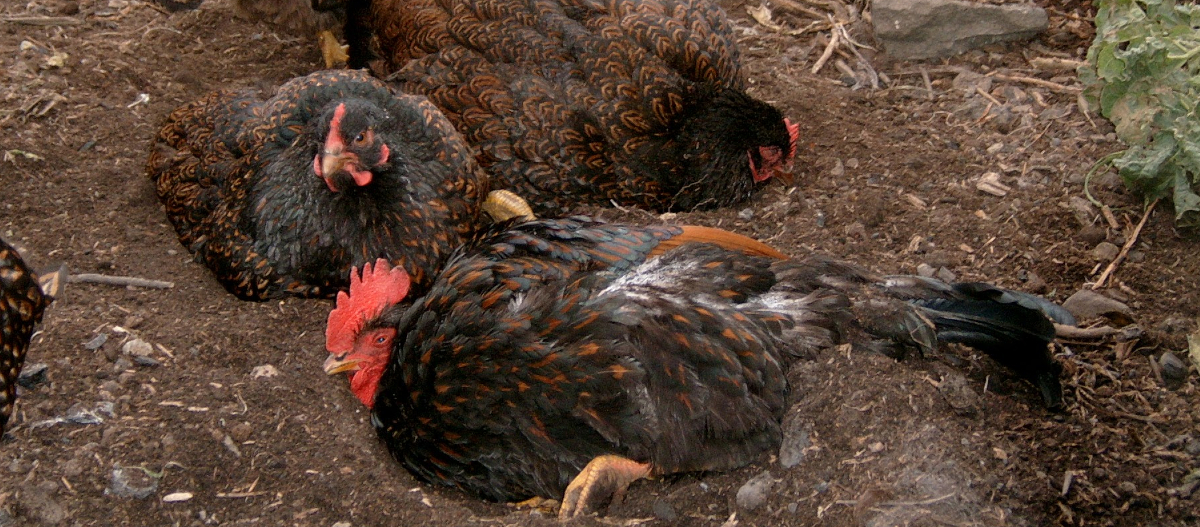
In my tests Diatomaceous earth has proven to be effective over time with regular use in controlling external parasites on your chickens, such as mites, fleas, lice and other external parasites that might infest feather follicles as well as pests on the poultry house.
I have been using diatomaceous earth on my poultry for a great many years.
Table of Contents
- Why use Diatomaceous earth on chickens?
- What is Diatomaceous earth?
- How does Diatomaceous earth work?
- What are the benefits of Diatomaceous earth?
- Which pests does Diatomaceous earth control?
- Are there any disadvantages to Diatomaceous earth?
- The complete guide to the safe use of DE on chickens:
- What is the dose for Diatomaceous earth?
- Internal Parasite Control with Diatomaceous earth :
- How much does Diatomaceous Earth cost?
- Where to buy Diatomaceous Earth:
- General Advice for Use of Diatomaceous earth:
- Use Diatomaceous earth as a feed additive:
- So does Diatomaceous earth work ?
It is also effective for some internal parasites and can supplement minerals in the diet. If you have hens that aren't laying too well, it may be caused by parasites.
Why use Diatomaceous earth on chickens?
In their study into the effects of diatomaceous earth on parasite load and egg production and quality in free range organic laying hens it was found that:
- Lower internal parasite loads – reducing the risk of infecting other birds.
- It is cheap, easy to get hold of and use, and stores well.
- Significantly heavier birds that laid more eggs with better feed efficiency.
- Birds on the DE diet laid larger eggs with bigger yolks.
- Controlled northern fowl mite effectively.
- Is completely safe, nontoxic and organic so has no egg withdrawal period.
- The birds on the DE diet laid eggs with heavier and thicker shells than those on the control diet.
- The DE birds laid 91 eggs in 100 days compared to 81 egg for the control.
Study basic criteria - 2 different breeds used. DE fed at 2% of diet. Study at Avian research centre, University of British Columbia by Bennett, Yee, Rhee and Cheng.
What is Diatomaceous earth?
Diatomaceous earth, also known by it’s abbreviation DE, is an off white greyish talc like powder that is the fossilised remains of marine phytoplankton called diatoms.
DE can be almost any colour from white to Gray and light Brown.
It is mined from old sea beds in a similar way to salt and then ground to a fine powder.
Below: What DE looks like.

Whilst not dangerous you should handle DE with some care as it can irritate the nasal passages and lungs and dry the skin.
How does Diatomaceous earth work?
Diatomaceous earth is a purely mechanical pesticide and it works by damaging the waxy cuticle or coating on insects and parasites that prevents them from drying out. It essentially desiccates the fleas, mites and worms and it does that by scratching them to death whilst it is completely non-toxic to the mammal.
In the intestines it scratched away at the protective layer allowing the digestive or immune processes to kill the parasite.
Below: This is one of my hens having a dust bath. I add DE to the dust baths and the hens dose themselves.
If you were to look at DE under a powerful microscope you will see the sharp random edges of silica that do the damage, the particles look like minute shards of glass and get into the joints on the exoskeleton and as the insect moves it literally cuts them up.
The Diatom is applied where insects live and move and will be picked up on the insect’s exoskeleton by static electricity.
Below: Red poultry mite, the poultry keepers enemy.
Unlike chemical pesticides results are not instant but may take several days, however the advantage of a natural product is that there is no egg withdrawal period necessary for poultry.
What are the benefits of diatomaceous earth?
- DE is a chemical free way of killing pests in the coop and on chickens.
- Diatomaceous earth is a great addition to the dust bath and nests for year round protection.
- Your flock can eat diatomaceous earth and it is beneficial for them.
- Chickens with DE in their diet have been shown to lay more eggs.
- Diatomaceous earth can be used as a feed additive and will keep your chicken feed pest free as well.
Which pests does diatomaceous earth control?
Internal parasites, Mites, Fleas, ticks, ants, roaches, spiders and scorpions, aphids, termites and flies and fly larvae. It only works through contact so the insect needs to be in contact with the DE.
Diatom can control red mite in poultry houses if it is thoroughly applied to walls, floors, perches and nest boxes or cages at 50 g per square metre.
A 2 kg tub will treat a backyard flock and coop several times over. Diatomaceous earth is odourless and non-toxic so poses no danger to the birds.
Are there any disadvantages to diatomaceous earth?
The disadvantages of using Diatomaceous earth on chickens are:
- It's not instant and takes time to work. It can take from 12 hours to 5 days to work completely.
- Best used regularly in small amounts. Diatomaceous earth works most effectively when applied in small amounts on a regular basis.
- May not deal with really heavy infestations. A high parasite load may cause a fatality before the DE can clear the infestation.
- It is more effective externally than internally and as such won’t effect lung-worms and Gape-worms in poultry, these will need a chemical treatment.
- You will need some safety gear to avoid getting in your eyes or lungs, and those of the bird. It can dry the skin and will cause sneezing at best and if you have asthma you will need a dust mask.
- Less effective on internal parasites – works better when it’s dry. It will help with internal parasites but treatment needs to be consistent and prolonged.
- Some people don’t understand how it works and use it in ineffective ways. It is not a bait and bugs won’t be drawn to it. You need to cover the widest area possible and not leave it in small piles.
- You need to buy it in relatively large amounts and keep it in storage. Keep it where it won’t make a mess and annoy any partners/wives/husbands when you spill it or puff it over the furniture.
- It will kill beneficial insects like bees in a blink so be very careful how you use it.
Below: The equipment you need to apply DE?
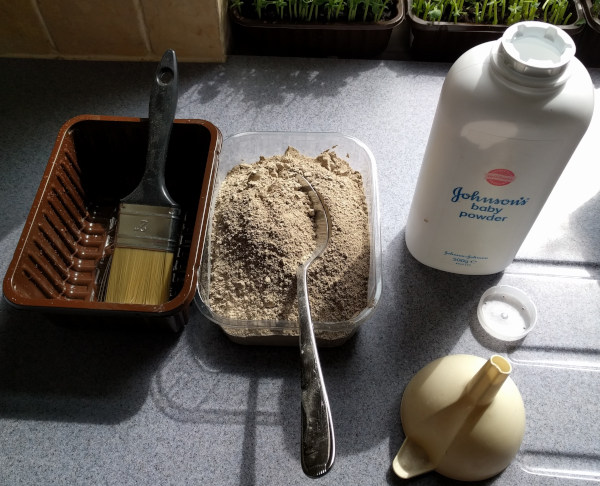
- Bulb puffer or talc bottle for dusting.
- Dust-mask.
- Funnel for filling
- Spoon, paintbrush and pot.
The complete guide to the safe use of DE on chickens:
Dusting the coop - this involves using a plastic bottle with little holes in the lid to puff dust into the nooks and crannies of the coop.
This method has the advantage of being effective immediately and easy to do. Using a puffer allows the Powder to get into all the little nooks and crannies of a coop and nest box.
Below: Wooden coop panels dusted with Diatomaceous earth.
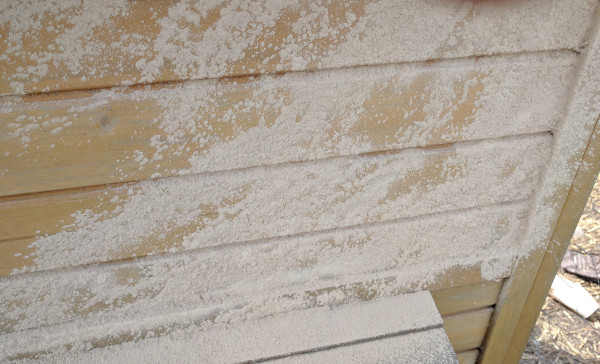
I have dusted the outside to make it a little clearer, apply liberally making sure it gets into all the cracks and gaps. Leave a surplus at the ends of the perches.
Use a brush to spread the DE into the cracks and corners of the coop.
Painting is the least effective method of application. Mix the DE with water till it forms a thin paste and paint it on to all the surfaces of the coop. When it dries you will get a thin layer of protection on every surface.
Below: Nest boxes – Two table spoon fulls sprinkled in the corners and edges of the nest box. Or puffed in as in the picture.
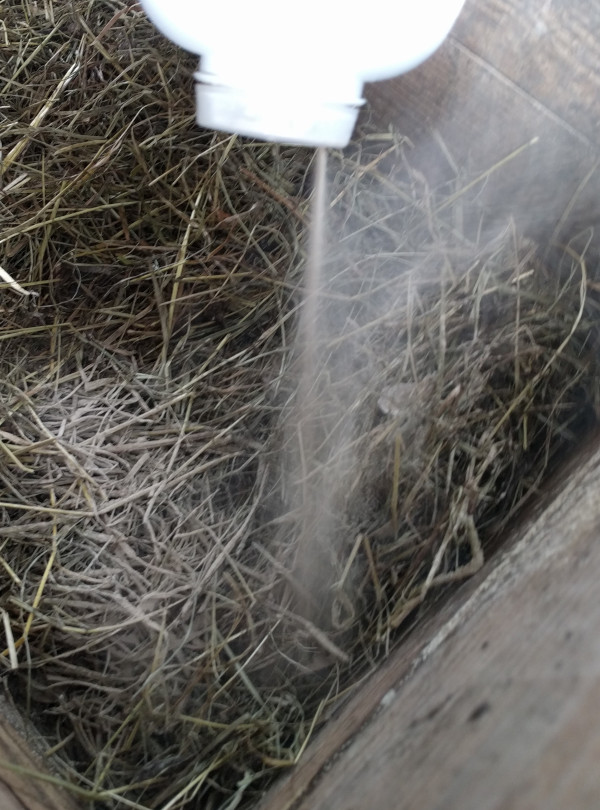
Broody hens – Always dust broody hens and their nests. This need not be as disruptive as you think. Simply slip a little under the feathers on their back with a teaspoon and dust around them in the broody box.
For the full guide on how and where to use DE and the dosages for poultry.
Use diatomaceous earth in the dust bath and your chickens will happily dose themselves. This is my favourite method of application as it is the easiest and result in no stress for the bird.
What is the dose for diatomaceous earth?
Since it is natural and organic you don't need to worry about using to much so buy the largest pack size you can afford and deal with, it is often cheaper to buy in bulk and won’t go off over time.
The dose of diatomaceous earth for dust baths is 500 g initially + 1 tablespoon for each bird that uses the dust bath. Add a tablespoon every three months.
Supplementing with ash from a wood fire is also useful.
The dose of diatomaceous earth is 1 teaspoon per chicken applied directly to the skin.
The dose of diatomaceous earth for a nest is 2 tablespoon per box spread evenly around the nest and getting into the corners.
The dose of diatomaceous earth as a food supplement is 2% of the food weight.
Avoid DE with additives buy food grade for assurance.
Dusting or spooning onto the hen – First get hold of the chicken and cover the head with a damp sock or cloth. Make sure you use a damp sock not wet and use one with a slightly loose weave, the idea is to stop the dust getting into the lungs and eyes and not to torture the chicken by waterboarding the bird. The darkness will help calm the bird while you dust the feathers.
Below: Here I am dusting a Barred Rock hen with diatomaceous earth using a puffer to get all the feathers. A damp cloth covers the hens face.
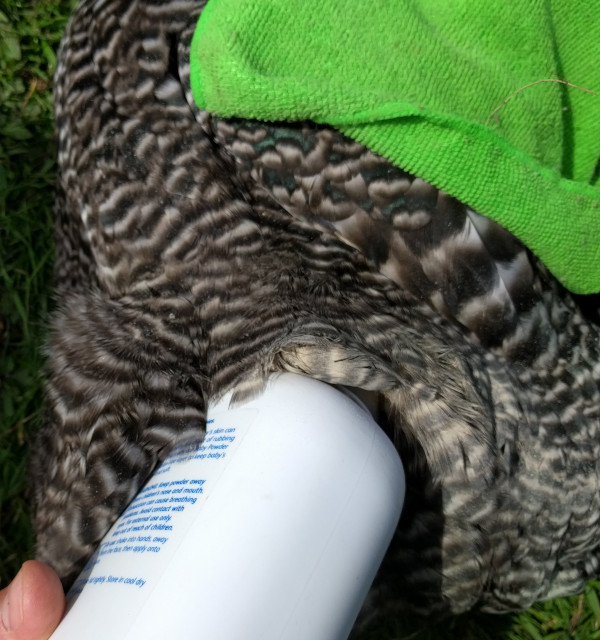
There will generally be a little flapping and some noise but it is more important to dust everywhere, making sure you get the powder down to the skin. Use a teaspoon to get the powder under the feathers or use the talc puffer we prepared earlier to puff the DE against the skin and into the feathers.
Get as far up the neck as you comfortably can and cover as much of the feathers and skin as possible. The bird will shake and help distribute the DE powder and will preen.
Chickens in a treated coop with no visible external parasites probably only need treating once in spring provided the have a dust bath to dose themselves.
Internal Parasite Control with diatomaceous earth :
It isn’t a quick fix, use diatomaceous earth for at least 60 days and preferably longer to cover the whole life cycle of the parasite.
Diatom has been used for decades as a natural wormer for livestock. It is believed that the DE scratches and damages the cuticle of internal parasites allowing digestive fluids and immune processes to act.
Below: The dose for chicken feed as an additive:
Regardless of the method of operation, farmers report definite control. For effective use, the Diatom must be fed long enough to catch all the newly hatching eggs and disrupt the life cycle.
A minimum of 60 days is suggested at 2% of dry weight of the grain ration.
A word of caution: Do not give to very small pregnant animals such as cats, guinea pigs etc. and do not feed continually to babies or very small adult animals such as cats or hamsters.
Diatoms mode of action for insect and parasite control is strictly mechanical. Both internal and external parasite and insect pest control with result in improvement in health, appearance and behaviour as well as assimilation of feed, which means improved weight gain and lowered feed costs.
How much does diatomaceous earth cost?
As a rule in the United States you can expect to pay between $4 and $6 a pound (lb) or between £2 and £3 a kilo if you are in the UK for decent quality DE powder.
The bigger the quantity you buy the better the bulk discount you will get.
Where to buy diatomaceous earth:
See our recommended poultry and chicken keeping products page.
General advice for use of diatomaceous earth:
When used at recommended rates Diatom has been effective against ants, aphids, worms, caterpillars, cockroach, clothes moth, earwig, house fly, fleas, fruit fly, leaf perforator, leaf hopper, mite, greenfly, black fly, red mite in poultry, weevil, red spider mite, carpet beetles, centipedes, ticks, millipedes, silverfish, slugs, snail and many other insects as a natural pest control method.
Use in cracks, crevices, hiding and running areas, behind appliances and wall and floor surfaces. It can be expected that most insects will die from contact with diatomaceous earth within a few days and it can also have a very good long-term residual effect. Can be safely used in the home, in offices, food preparation establishments and schools
Control will be reduced if the Diatom is exposed to high relative humidity (75% or above) and the diatom shells absorb moisture, but when it dries out again it will still be as effective.
It is good to consider insect life cycles when applying Diatom to coincide with larval/pupae stages becoming adult. Long term protection and control of insects can be achieved, and because of the physical means of control, not chemical, the insect cannot build up a resistance in future generations.
It has most effectiveness on larvae and adult insects with a fair amount of soft tissue exposure.
Indoor and Outdoor application: Sprinkle a light layer of Diatom in areas where pests frequent, including under cookers, cabinets, sinks, dustbins, window and door frames and sills, entrance ways, sewer pipes and drains and in cracks and crevices. Repeat treatment as needed.
For carpet beetles: Thoroughly dust along skirting boards, carpet edges, under furniture, carpets and rugs, and in closets and shelving.
For Fleas: Thoroughly dust carpets and pet’s bedding and sleeping areas. It can also be rubbed into pets fur or your chickens feathers.
For Flies: Thoroughly dust areas where flies frequent, straw bedding, and livestock pens. Can also be applied to livestock coat as an insect repellent/ contact insecticide.
It has been noted that when used as a wormer for cattle, the undigested Diatom passes through with the manure and reduced fly hatching has been observed in cattle fed on Diatom.
Diatomaceous earth in the garden: 100% natural product used as an effective barrier against Slugs and Snails. Sprinkle around flower and vegetable gardens. If getting saturated effectiveness will be reduced, but once dried out will continue to work as before.
Use diatomaceous earth as a feed additive:
Add it to stored grains and feed to kill and pests and coat the grains in DE to feed to the hens.
And lastly but not least – add Minerals to the diet:
What about the mineral content of Diatom? If oyster shell and grit provides calcium and minerals, then finely ground Diatom may also provide a broad-spectrum of naturally occurring chelated minerals which include calcium, magnesium, iron, phosphate, sodium, titanium, potassium and others.
With lack of mineralisation in modern grains it isn’t hard to conceive of mineral benefits from a finely ground natural mineral product. Feeding at 2% of grain ration can take care of both deworming and mineralisation.
So does diatomaceous earth work ?
Yes, it does - I tested it on insects and it kills them in a jar inside 24 hours. Also I have never had to resort to chemical means for parasites. Despite having a lot of chickens.
It also provides easily accessible minerals into the poultry diet to support the health of the bird.
Below: Here is one of my tests on insects with DE, it reliably killed all parasites within 24 hours.
Diatomaceous earth is the ounce of prevention that is infinitely superior to the pound of cure. It is best used as a preventative measure.
Do yourself a solid favour and buy food grade, it will be free from additives and not the stuff that is used in the pool filter business or industry.
I wouldn’t be without diatomaceous earth in my chicken supplies.
